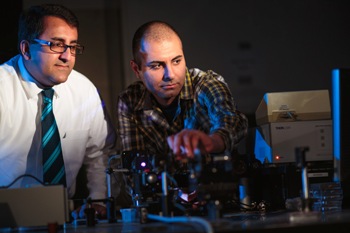Apr 17 2013
Researchers at the University of Wisconsin-Milwaukee (UWM) have found a new mechanism to transmit light through optical fibers. Their discovery marks the first practical application of a Nobel-Prize-winning phenomenon that was proposed in 1958.
 Arash Mafi (left), associate professor of electrical engineering, consults with his doctoral student Salman Karbasi. Karbasi designed an optical fiber that traps a beam of light traversing an optical fiber in a unique way. The discovery could usher in the next generation of data transmission methods. Credit: Peter Jakubowski
Arash Mafi (left), associate professor of electrical engineering, consults with his doctoral student Salman Karbasi. Karbasi designed an optical fiber that traps a beam of light traversing an optical fiber in a unique way. The discovery could usher in the next generation of data transmission methods. Credit: Peter Jakubowski
Assistant Professor Arash Mafi and doctoral student Salman Karbasi harnessed “Anderson localization” to create an optical fiber with a strong scattering mechanism that traps the beam of light as it traverses the fiber. The work was done in collaboration with Karl Koch, a scientist with Corning Inc.
Data transmission through conventional optical fibers – in which only one spatial channel of light traverses the fiber – is the backbone of the Internet. Such single-core fibers, however, are reaching the limits of their information-carrying capacity, says Mafi.
Propagation of multiple optical beams in a single strand of optical fiber is a sought-after solution to overcome this limitation. The collaboration’s novel discovery achieves this.
The work has potential in next-generation high-speed communication and biomedical imaging, but it also opens the door for more uses of “Anderson localization” in technology.
“Anderson localization” is named after physicist Philip W. Anderson, who first theoretically observed the curious containment of electrons in a highly disordered medium, an observation for which he shared the 1977 Nobel Prize in physics, but one that is still under investigation.
Mafi and Karbasi’s fiber design consists of two randomly distributed materials, which scatter the photons.
The fiber’s disordered interior causes a beam of light traveling through it to freeze laterally. The output light can follow any shift in the location of the entry point as it moves around on the cross-section of the fiber.
Karbasi says his theoretical calculations indicated that the proper fiber design would take advantage of Anderson localization. “We designed our fiber so that it provides more physical places where the light can propagate,” says Karbasi.
Their research, backed by a grant from the National Science Foundation, was published last summer in the journal Optics Letters.
The collaborators are currently working on forming and transmitting images using their unique method.
Before joining UWM’s College of Engineering & Applied Science in 2008, Mafi was a senior research scientist at Corning Inc., the world’s largest manufacturer of optical fibers. He earned an NSF Early CAREER award earlier this year.
Karbasi is first author on the publications. He has been studying with Mafi at UWM since 2009, after receiving his bachelor’s and master’s degrees in Iran.
https://pantherfile.uwm.edu/mafi/www/research.html